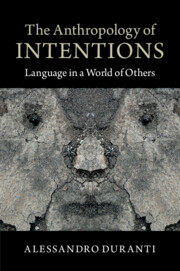Book contents
- Frontmatter
- Contents
- List of figures
- Acknowledgments
- 1 Rethinking anti-intentionalism
- 2 Intentions in speaking and acting: the Standard Theory and its foes
- 3 The avoidance of intentional discourse: a Samoan case study
- 4 The invention of promising in the Samoan translation of the Bible
- 5 Intentionality and truth, revisited
- 6 Speaker intentions and the role of the audience in a political campaign in the US
- 7 A dialogue on intentions
- 8 Opacity of other minds: local theories revisited
- 9 Intentions and their modifications: a lesson from Husserl
- 10 A sense of the other: from intentionality to intersubjectivity
- 11 The intentional continuum
- Appendix A Transcription conventions for English examples
- Appendix B Transcription conventions and abbreviations used in the Samoan examples
- Notes
- References
- Index
9 - Intentions and their modifications: a lesson from Husserl
Published online by Cambridge University Press: 18 December 2014
- Frontmatter
- Contents
- List of figures
- Acknowledgments
- 1 Rethinking anti-intentionalism
- 2 Intentions in speaking and acting: the Standard Theory and its foes
- 3 The avoidance of intentional discourse: a Samoan case study
- 4 The invention of promising in the Samoan translation of the Bible
- 5 Intentionality and truth, revisited
- 6 Speaker intentions and the role of the audience in a political campaign in the US
- 7 A dialogue on intentions
- 8 Opacity of other minds: local theories revisited
- 9 Intentions and their modifications: a lesson from Husserl
- 10 A sense of the other: from intentionality to intersubjectivity
- 11 The intentional continuum
- Appendix A Transcription conventions for English examples
- Appendix B Transcription conventions and abbreviations used in the Samoan examples
- Notes
- References
- Index
Summary
Introduction
In this chapter I return to Husserl’s notion of intention, which I briefly introduced in Chapter 2 (§2.4), and combine it with his notion of “modification” to describe the role that directing novices’ attention plays in socialization. I also use Husserl’s conceptual apparatus to hypothesize that, even though children and novices have ways to modify their habitual way of being and the ability to assume what Husserl called a “theoretical attitude,” the accumulation of earlier intentional and phenomenal modifications into a well-established habitus might prevent certain changes and thus certain types of learning from occurring.
Husserl’s intentionality and the relationship with the modification of attention
For Husserl, intentionality covers a wide range of acts that go from transforming raw sensations into a meaningful entity (e.g., a sequence of sounds into a song) to combining several such experiences into more complex meanings (e.g., the remembering of the time when we heard that song for the first time). An important element of Husserl’s phenomenology is the key role of attention.
We speak of intending … in the sense of specially noticing, or attending to something [im Sinne des auf etwas speciell Achtens, des Aufmerkens]. An intentional object need not, however always be noticed or attended to. Several acts may be present and interwoven with one another, but attention is emphatically active in one of them. We experience them all at the same time, but we get absorbed by this particular one.
(Husserl 1901: 557; translation, here slightly altered, in 1970b: 562)By bringing some objects to the foreground while leaving others in the background, attention is one of the ways in which the temporality of our being-in-the-world gets realized (Arvidson 2003, 2006; Depraz 2004; Husserl 2004). To better capture the different ways in which the phenomenal world changes for the perceiving, thinking, acting, and interacting Subject, Husserl at times used the notion of “modification” (German Modifikation) – a term that bears a family resemblance with other terms also used by Husserl, including Wandlung, Abwandlung, and Änderung – combined with a number of adjectives that express different experiences as well as different theoretical points of view.
- Type
- Chapter
- Information
- The Anthropology of IntentionsLanguage in a World of Others, pp. 187 - 208Publisher: Cambridge University PressPrint publication year: 2015

